Content marketing is the core component in all your marketing channels. Blog posts, marketing literature, email campaigns, advertising: without great content, they all fall flat.
Effective content marketing can help you attract more customers, improve your brand positioning, and optimize your marketing funnel.
Content marketing is more art than science. To help get your creative juices flowing, we’ll look at six examples of great content marketing.
6 best content marketing examples you can learn from:
- Mailchimp’s content style guide
- Digital Ocean’s tutorials
- Charmin’s Sit or Squat campaign
- GE’s #GEInstaWalk
- ZenDesk’s ZenDesk Alternative
- HubSpot’s academy
Overview: What is content marketing?
Content marketing is targeted content designed to boost brand image, increase sales, and/or build awareness. Content marketing comes in many forms including blogs, listicles, tutorials, videos, landing pages, and infographics.
If you’re familiar with the principles of marketing, content marketing falls into the “promotion” category. Large enterprise marketing strategies and small local businesses marketing efforts can benefit from content marketing.
You can use processes and tools to help your content stand out. A content management system (CMS) such as WordPress simplifies publishing content, but, supplement it with an add-on such as the Yoast plugin, and you will improve your content’s SEO quality, helping you rank higher in Google searches.
What all successful content marketing examples have in common
There’s no one-size-fits-all answer to designing successful marketing campaigns. Every industry, customer base, and business is different. But each meets certain table stakes criteria for quality content marketing.
Let’s take a look at what most of the best content marketing campaigns have in common.
1. Targeted
The best advice I can give you on successful content marketing: know what resonates with your target customer, then optimize for that. Everyone won’t find your content engaging, and that shouldn’t be your goal. Know and key in on your target audience and optimize for them.
2. Valuable
Your content needs to be valuable to your audience. Maybe it teaches them how to do something, answers an interesting question, or simply gets them to laugh. The key here is to ensure that you're not creating content for content’s sake.
Deliver value to your target audience. A good way to do this is by tracking marketing metrics around engagement and action. Invest in marketing analytics tools to understand how you can iterate and improve. For example, UTM (Urchin Tracking Module) links help you track how many clicks a blog post generated.
3. Discoverable
A large social media presence and a good email list can ensure your content is discoverable by the right people.
But don’t overlook the importance of SEO. Search engines often determine what gets viewed and what doesn’t. As a result, content optimization is critical. Most of us are familiar with the idea of optimizing for a given keyword, but do you understand “technical SEO”?
Technical SEO covers optimizing your website for the web crawlers that search engines use to discover and categorize your content. It can be an intimidating topic initially, but the right CMS platform can go a long way here. For example, Wix optimizes meta tags and sets canonical URLs, two key SEO tasks.
4. Timely
Deliver your message late (on the 5th of July for a July 4 sale) and none of the previous points matter. Some content is “evergreen” and can be useful forever, but other content may have the shelf life of a banana.
For example, any content marketing surrounding a marketing event drops dramatically after the event occurs. This is where tools like email marketing platforms, social media management software, and a social media content calendar can help.
6 great content marketing examples
Now that we understand the basics, let’s dive into some examples of great content marketing. We will look at six examples of content marketing that were effective in capturing the attention of their target audience and delivered value.
1. Mailchimp’s content style guide
Mailchimp is one of the leading email marketing platforms available today, so it’s no surprise they know a thing or two about effective marketing. We can choose from many Mailchimp examples, but I chose their content style guide because it resonated with me.
I write content and recognize how indispensable a style guide is. Teams can use it as an authoritative reference to create uniform content. Mailchimp’s guide has a lot of thought behind it.
It’s something I’ll use because it can help me solve a real problem. The benefit to Mailchimp? First off, I associate their brand with something positive, and when the need for an email marketing tool comes up, Mailchimp will be one of the first names that comes to mind.
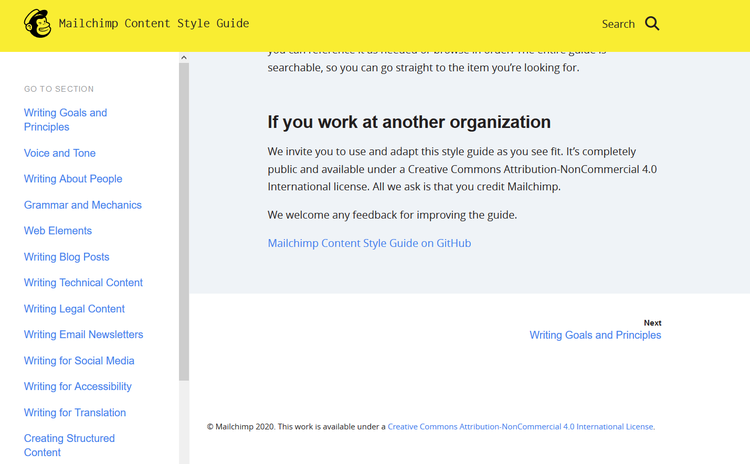
Mailchimp's content style guide begins with an introduction for Mailchimp and external users. Image source: Author
What you can take from Mailchimp’s content style guide:
Reading Mailchimp’s style guide gives you several pointers on content creation. But perhaps even more importantly, their style guide gives you additional takeaways about effective content marketing:
- Create content that solves problems: Many writing teams have the problem “how do we make content uniform”? Mailchimp provides a practical solution. And it also happens that many people with this problem are marketers that could benefit from Mailchimp’s product.
- Leverage useful internal content: It’s likely Mailchimp needed a style guide. Their decision to put it out to the world was a wise content marketing decision. If you create internal content for your business that could benefit a wider audience, consider making it public to create a win-win scenario.
2. Digital Ocean’s tutorials
Digital Ocean is an Infrastructure as a Service (IaaS) provider that competes with some of the biggest companies in the world. To help attract attention to their platform, they’ve amassed a repository of tutorials.
These tutorials help their target audience of developers and other technical professionals complete tasks that might take significantly longer without such a resource.
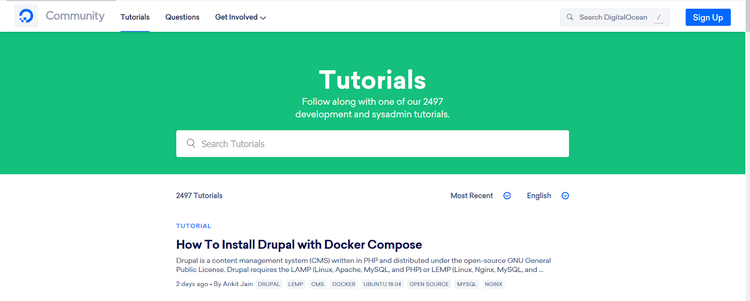
Digital Ocean’s tutorials home page links to recent tutorials and includes a search bar. Image source: Author
What you can take from Digital Ocean’s tutorials:
Digital Ocean’s tutorials are a great example of focusing on value. I’ve personally referenced their tutorials for projects I’ve worked on, and found them a solid resource.
They don’t force you to provide an email address or hide content behind a paywall. They simply deliver value and slap their name on it. Here’s what you can learn from them:
- Don’t sell too much: Asking for the sale is important, but so is context. Being too pushy at the wrong time can be off-putting. In top-of-funnel content, focus on delivering value more than closing.
- Incentivize user-generated content: Having a team large enough to consistently generate content isn’t always practical. Digital Ocean gets around this problem by incentivizing site visitors to contribute content with programs like their “Write for Donations” program where they pay for tutorials AND make a matching charitable donation.
3. Charmin’s Sit or Squat campaign
Charmin’s Sit or Squat campaign is a great example of the power of getting people to talk by creating shareable content. With this campaign, Charmin sparked a conversation around clean public restrooms, built an app to help users determine the cleanliness of public bathrooms, and boosted their brand image.
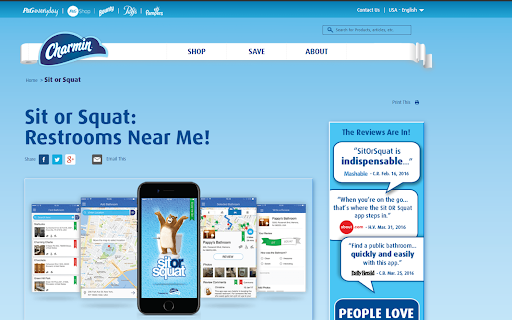
The landing page for Charmin’s sit or squat campaign includes reviews and pictures of their app. Image source: Author
What you can take from Charmin’s Sit or Squat campaign:
Charmin has what many would consider a boring product (before toilet paper shortages made headlines). However, they found a way to engage with consumers and create shareable content. Key takeaways from this campaign include:
- Tie in social media: The #SitorSquat hashtag made it easy for Charmin to get people sharing their content across different social media platforms. When possible, look to follow their lead and create catchy and shareable hashtags to complement your content marketing.
- Get people talking: Most people can relate to Charmin’s campaign, but not many people were talking about it before. This created an opportunity for Charmin to spark a conversation, and it paid off.
4. GE’s #GEInstaWalk
General Electric’s #GEInstaWalk is another example of a company starting a compelling conversation that promotes sharing and user generated content. In this case, GE gave fans and influencers the opportunity to tour a plant where jet engines are manufactured.
The combination of access, expert Instagram photographers, and a unique environment took off and yielded excellent results. The campaign created 3.8 million views and 3,000 new followers on the GE Instagram account, with no paid advertising (Source: Shorty Awards).

An Instagram page showing 3 pictures filed under the #geinstawalk hashtag. Image source: Author
What you can take from GE’s #GEInstaWalk:
The #GEInstaWalk campaign is a good case study around photographic and video-based content. If you can create compelling visual content as GE did, you can increase your chances of going viral and boosting your online presence. So what can we learn from GE?
- Create cool photo-ops: Selfies are everywhere. People love a unique photo-op. If you can tie one into your brand, you can go a long way in making your content stand out.
- Use influencers effectively: Influencers have become quite the marketing buzzword in recent years. Here, GE used influencers and normal users in a way that was organic and eye-catching. Aim to replicate those results in your social media content.
5. ZenDesk’s ZenDesk Alternative
If your product or service becomes popular enough, it’s almost inevitable that people will search for “your product alternative”. ZenDesk ran into just that problem in the mid-2010s.
As a tongue-in-cheek way to create some buzz, ZenDesk launched http://zendeskalternative.com/. A page ostensibly dedicated to an alternative rock band from Seattle named “ZenDesk Alternative”.
It was a creative way to generate some buzz, win some goodwill, and maybe even take eyes off the competition.
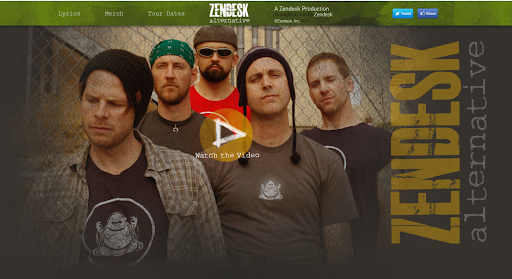
A picture of the five men who make up “ZenDesk Alternative” on the ZenDesk Alternative website. Image source: Author
What you can take from ZenDesk’s ZenDesk Alternative:
ZenDesk’s alternative campaign shows us that a sense of humor pays off. While it may not have stopped many customers from switching away directly, it generated some positive buzz and got attention on the brand. Here’s what we can learn from them:
- Don’t be afraid to use humor: Poking fun at yourself and using humor in your content can be a great way to boost engagement. Business is serious, but not every marketing campaign has to be.
- Good SEO can reap continued rewards: The ZenDesk Alternative webpage continues to pop up in search results four years after publication. This helps provide a real world example of how effective SEO optimization can be in making your content discoverable for years to come.
6. HubSpot’s academy
HubSpot has been credited with coining the term inbound marketing, so it’s no surprise that the CRM maker has excellent examples of content marketing.
One of my favorites is the HubSpot Academy. In the academy, users can take free online marketing courses and even earn certifications. This is another example of giving value to reap rewards long term. Marketers that learn from HubSpot will be more likely to use their tools.
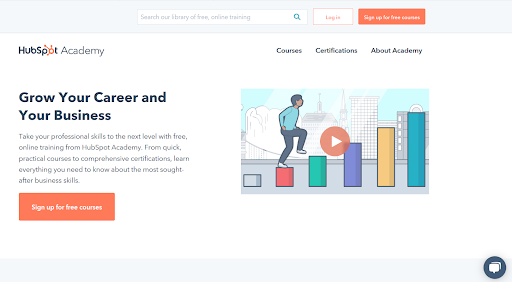
The HubSpot Academy landing page includes a search bar for training content, login and signup buttons, and an introductory video. Image source: Author
What you can take from HubSpot’s academy:
HubSpot Academy is a case study in the benefits of providing your target audience with value while building authority. HubSpot is viewed as an authority on many marketing subjects because of their content. Lessons to be learned from HubSpot include:
- Create a course: Online courses are an excellent way to establish your authority as a thought leader. And they can help you turn standard users into power users and brand advocates.
- Break up content into consumable chunks: An online course can be a lot to take on, and people may be averse to hour-long sessions when getting started. HubSpot addresses this by providing videos that are labeled “short courses”. Even if you aren’t designing courses, keep “consumable chunks” in mind for your content marketing.
Remember: Context is key
We hope you enjoyed our list of content marketing examples and learned valuable tips along the way. As you move forward in developing your content marketing strategy, remember that context is key.
Contextualizing your content for your target audience will help you create campaigns that are organic, authentic, and compelling.
Our Small Business Expert
We're firm believers in the Golden Rule, which is why editorial opinions are ours alone and have not been previously reviewed, approved, or endorsed by included advertisers. The Ascent does not cover all offers on the market. Editorial content from The Ascent is separate from The Motley Fool editorial content and is created by a different analyst team.